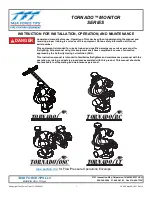
9
11.7 Rotor removal
First, remove the drum as described previously. Undo
the eight bolts securing the rotor sealing ring / screen
and lower segment to the housing assembly and
remove. Suspend the rotor from a lifting device so
that it can be removed safely. Wedge the rotor to
prevent rotation and unscrew the bolt in the centre of
the rotor.
The rotor is located on a taper and will usually require
a sharp blow to be administered to the end of the rotor
shaft to dislodge it. Care should be taken not to
damage the tapped hole in the end of the shaft. On
machines equipped with a mill rotor, a rotor removal
tool is available, this releases the rotor from the
tapered shaft. The part number for the rotor removal
tool is
SC1757
.
The refitting procedure is a reversal of the above
11.8 PTO shaft
Check once a week that the clamp bolts on the rotor
shaft are tight and that there is no free play on the
splines.
Access to the grease nipples for the PTO shaft joints is
via a hole in the cone.
11.9 PTO slip clutch
If the clutch slips repeatedly for no apparent reason, it
should be adjusted as follows.
1. Remove the large metal guard fitted over the
clutch.
2. Insert a piece of wood through the top discharge
chute and position it such that it prevents the rotor
from turning.
3. Insert a steel bar through the rear PTO yoke and
use a spring balance to obtain the correct torque
setting. The clutch should just slip at a torque of
1200 Nm (900 lb.ft.) - equal to a force of 1200N at
1 metre (300 lb. at 3 feet) from the centre of the
yoke. Adjust the clutch as necessary using the
eight spring loaded clamp bolts. If the clutch
linings show signs of damage or excessive wear,
they should be replaced. When new they are
3mm (1/8") thick.
11.10 Drum drive belt adjustment
The belt tension should be sufficient for slip not to
occur, but over tightening should be avoided.
Tensioning is carried out by means of an adjuster
attached to the motor bracket.
If the belts slip persistently, check that the drum is not
fouling on the back plate.
If the belts turn over in their grooves or appear to run
out of alignment, the position of the motor pulleys
should be adjusted by means of the large nuts on the
threaded pivot shaft.
11.11 Booster fan pump drive belt adjustment
WARNING
. Never attempt to tension the pump
drive belts unless the PTO has been disengaged,
the engine has been stopped, the key removed and
the machine come to rest.
Fig. 7 Belt deflection measurement
To tension the belts driving the hydraulic pump, loosen
the four locking bolts in their slots on the pump mount
plate. Next loosen the two lowest nuts on the tension
screw and wind the lowest nut in to pull the pump
assembly lower. Belt tension is correct when at mid
centre distance of the belt a deflection of 7.9mm is
created when a force of 75N is applied at that point.
Figure 7 shows where the force is applied and the
deflection measured. There is a slot in the housing at
mid centre distance through which deflection can be
measured.
Once tension is correctly set the nuts can be locked
off on the tension screw and the four locking bolts in
the pump mounting plate retightened.
If the drive belts require replacement it will be
necessary to remove from the bearing housing the red
guard on the lower rear face, the circular red PTO
guard and the PTO shaft itself. The four locking bolts
on the pump housing should be loosened and using
the two lower nuts on the tension screw raise the
pump and its mount plate as high as possible in its
slots. With the pump fully raised it should now be
possible to feed the belts off the pulleys and replace
with new matched belts.
The new belts should be tensioned using the nuts on
the tension screw, the locking bolts should be
tightened to secure the pump mounting plate. The
PTO shaft and guards can now be refitted.
Operate the machine for 10 - 15 minutes to test
operation. Afterwards with the PTO disengaged, the
engine stopped, the key removed and the machine






































